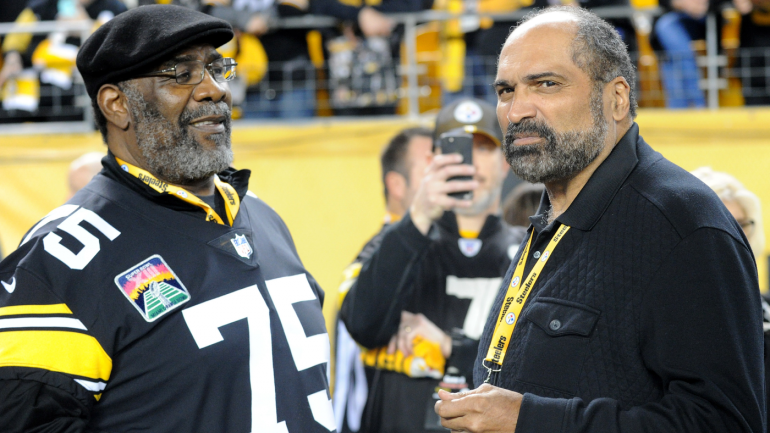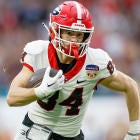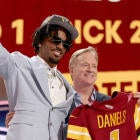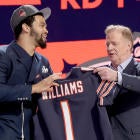
Since 1972, no NFL team has been as consistently good as the Pittsburgh Steelers. In the 1970s, the Steelers were so dominant that NFL Films narrator John Facenda once said, "There are 27 teams in the National Football League, and then, there are the Pittsburgh Steelers."
Since '72, the year Franco Harris' "Immaculate Reception" gave the franchise its first playoff victory, the Steelers have enjoyed riches few other NFL franchises have ever reached. From 1974-79, the Steelers won four Super Bowls in a six-year span, a feat that has yet to be matched. Two decades later, the Blitzburgh Steelers won five straight division titles while appearing on three AFC title games as well as the franchise's fifth Super Bowl.
In the 2000s, the Steelers added to their collection of Vince Lombardi trophies, winning Super Bowls XL and XLIII behind a young quarterback, two passionate coaches and a dominant defense. Pittsburgh advanced to its ninth Super Bowl as the start of this decade, and they will leave the decade with at least three more division titles and a 16th AFC Championship Game appearance.
While Art and Dan Rooney, draft specialists Art Rooney Jr. and Bill Nunn, and head coaches Bill Cowher and Mike Tomlin (among others) were key contributors to Pittsburgh's success over the past 50 years, the men who made up those Steelers teams are who we are choosing to recognize while selecting the 10 greatest players in the franchise's last half-century.
With the help of CBS Sports NFL analyst Cowher, former Steelers Super Bowl-winning cornerback and current CBS Sports HQ NFL analyst Bryant McFadden and CBS writer Ryan Wilson, here is my list of the 10 greatest Steelers since 1972.
1. Joe Greene
The first man Chuck Noll selected after becoming the Steelers head coach, Greene's play on the field and unyielding drive to become a champion helped drive Pittsburgh's success throughout their dynasty run. The league's Defensive Player of the Year in 1972 and in 1974, Greene spearheaded Pittsburgh's legendary "Steel Curtain" defense that held the mighty Oakland Raiders to just 29 yards rushing in the '74 AFC title game and the Minnesota Vikings to 17 yards on the ground in Super Bowl IX, Pittsburgh's first of four Super Bowl wins during the decade. In Super Bowl IX, Greene recorded an interception and a fumble recovery while ending the Steelers' 42-year championship wait.
By request from @WaltNYC
— Tomlin Reactions (@TomlinReactions) August 3, 2018
Joe Greene in his post game interview from Super Bowl IX pic.twitter.com/l5pSW7xaGE
Greene, a first ballot inductee into the Pro Football Hall of Fame, won two more Super Bowls with the franchise as a member of the team's scouting department. His No. 75 jersey was officially retired by the club in 2014.
2. Franco Harris
Franco and his Italian Army took Pittsburgh by storm throughout his magical rookie season of 1972 that ended with his "Immaculate Reception" in Pittsburgh's playoff victory over Oakland. Harris' success continued throughout the decade, earning nine consecutive Pro Bowl honors while leaving the '70s as the third leading rusher in NFL history.
A first ballot member of the Pro Football Hall of Fame, Harris remains the Super Bowl's career rushing leader with 354 yards. His 158 yards in Super Bowl IX earned him MVP honors while leading the Steelers to a 16-6 victory. His 22-yard touchdown gallup late in Super Bowl XIII helped the Steelers defeat the Cowboys for the second time in Super Bowl competition, while his two touchdowns and 112 all-purpose yards helped the Steelers beat the gritty Rams in Super Bowl XIV.
His death at age 72 comes days before the Steelers are scheduled to retire his No. 32 during a halftime ceremony amid Pittsburgh's Week 16 matchup with the Raiders.
Classic Clip of the Day...
— Steel City Star (@steelcitystar) July 24, 2019
Super Bowl IX MVP
FRANCO HARRIS
Here are his 5 best runs, shown chronologically, as he compiled a total of 34 carries for a then SB record 158 yards and a touchdown. @francoharrishof pic.twitter.com/QIKLEAfiQe
3. Terry Bradshaw
The Blonde Bomber, Bradshaw overcame a slow start to his career to become the first quarterback to win four Super Bowls. He also became the second player to win two Super Bowl MVP awards while throwing for a combined 627 yards and six touchdowns in Pittsburgh's wins in Super Bowls XIII and XIV.
The league's MVP in 1978, Bradshaw threw a touchdown in the fourth quarter in each of Pittsburgh's Super Bowl victories during the 1970s. In Super Bowl X, his 64-yard touchdown pass to Lynn Swann capped the Steelers 21-17 win over Dallas. Three years later, Bradshaw put together one of the greatest performances in Super Bowl history, throwing for a then-Super Bowl record 318 yards and four touchdowns in a 35-31 win over Dallas. In Super Bowl XIV, his 73 and 45 yard, fourth quarter completions to John Stallworth capped Pittsburgh's 31-19 victory over the Los Angeles Rams.
Super Bowl IX 🏆
— Pittsburgh Steelers (@steelers) September 3, 2018
Super Bowl X 🏆
Super Bowl XIII 🏆
Super Bowl XIV 🏆
Terry Bradshaw's trophy case is pretty full. #HappyBirthday pic.twitter.com/ICoHTGCJ8o
4. Ben Roethlisberger
"Big" Ben Roethlisberger was the cornerstone behind the Steelers' recent run of success before retiring this year. Since 2004, the year Roethlisberger became Pittsburgh's starting quarterback, the team has not had a losing record. Big Ben, the franchise's all-time leader in passing attempts, completions, yards, touchdowns and wins by a starting quarterback, became the youngest starting quarterback to win a Super Bowl after helping lead the Steelers to victory in Super Bowl XL. He also became the first starting quarterback to win three road playoff games in the same postseason.
In Super Bowl XLIII, Roethlisberger's last-minute, game-winning touchdown pass to Santonio Holmes helped deliver a sixth Vince Lombardi Trophy to Pittsburgh.
Making big-time plays at big-time moments.
— Pittsburgh Steelers (@steelers) October 5, 2019
Super Bowl XLIII takes no. 12 on the #NFL100 Greatest Games countdown. pic.twitter.com/9BVSiLajfw
This decade, Roethlisberger has added a third Super Bowl appearance, four more Pro Bowls and a league passing title to his resume. His is now top 10 all time in career passing yards, passing touchdowns and wins by a starting quarterback.
5. Jack Lambert
Jack Lambert was the physical embodiment of Pittsburgh Steelers football during the 1970s. A man who once said "Give me a six-pack and let's go play 'em again," Lambert brought a physical and intimidating edge to a Pittsburgh defense that was already pretty frightening heading into the 1974 season. But with Lambert in the lineup, the Steelers' defense became arguably the greatest unit in NFL history.
In Super Bowl X, Lambert's throw-down of Cowboys safety Cliff Harris turned the game's momentum in Pittsburgh's favor. Lambert backed up his actions by recording 14 tackles in Pittsburgh's four-point win. Later that year, he would earn Defensive Player of the Year honors before serving as a key member of the Steelers' final two Super Bowl teams of the decade. In Super Bowl XIV, Lambert, a first ballot member of the Pro Football Hall of Fame, recorded a key interception late in the game that set up Harris' game-clinching touchdown.
On this day in #SteelersHistory, Jack Lambert was drafted in 1974.
— Pittsburgh Steelers (@steelers) January 29, 2016
MORE: https://t.co/ELxgsylXjrhttps://t.co/99gCHr7Fod
6. Mel Blount
The team's all-time leader with 53 career interceptions, Mel Blount was so good that the NFL changed the rules in 1978 limiting the amount of contact a defensive back could have with a receiver beyond five yards. The rule, known in the years since as the Mel Blount Rule, was supposed to slow Blount and the Steelers down. Instead, Blount earned yet another Pro Bowl selection that season while Pittsburgh won a league high 14 games en route to their third Super Bowl in a five-year span. In that year's Super Bowl, Blount, a physical specimen at the time at 6-foot-3 and 205 pounds, recorded his third interception in Super Bowl play while helping the Steelers defeat the Cowboys.
Mel Blount was so good they had to change the rules 👀 @steelers pic.twitter.com/PuO7awADLP
— NFL Throwback (@nflthrowback) April 11, 2019
Blount, a first ballot member of the Hall of Fame, was named the NFL's Defensive Player of the Year in 1975.
7. Troy Polamalu
An eight-time Pro Bowler and four-time All-Pro, Troy Polamalu is not only regarded as one of the greatest safeties of his era, he is often mentioned as one of the greatest safeties of all time.
A unique athlete, Polamalu was the exclamation point to a Pittsburgh defense that was routinely one of the NFL's most dominant groups during the 2000s. The league's Defensive Player of the Year in 2010, Polamalu's player helped the Steelers win two Super Bowls and three AFC titles during a six-year span.
While he made many memorable plays during his career, Polamlau, who will likely be inducted into the Pro Football Hall of Fame next summer, is most remembered for his game-clinching interception return for a score in Pittsburgh's victory over Baltimore in the 2008 AFC Championship Game.
3️⃣ interceptions
— Pittsburgh Steelers (@steelers) September 28, 2019
3️⃣ sacks
2️⃣3️⃣-1️⃣4️⃣ win over Baltimore
Coming in at #98 on the #NFL100 Greatest Games countdown: the 2008 AFC Championship game vs. the Ravens. pic.twitter.com/MsNfRqBZlS
8. Jerome Bettis
The inspiration behind Pittsburgh's 2005 championship run, Bettis was the Steelers' best player from 1996 (his first season with the Steelers) until Hines Ward, Joey Porter, Polamalu and Roethlisberger took over the reigns in 2004. Bettis, a 1,000-yard rusher in each of his first six season in Pittsburgh, was still a force late in his career, earning Pro Bowl honors in 2004 at the age of 32 while helping the Steelers win a franchise record 15 regular season games.
The seventh leading rusher in NFL history and member of the Pro Football Hall of Fame, Bettis' 1997 season is arguably the best single season rushing season in franchise history. That season, Bettis rushed for 1,665 yards despite sitting out the final game of the regular season. He tallied 10 100-yard rushing performances that season that included 125 yards in a Week 15 win over the eventual Super Bowl champion Denver Broncos. His 101-yard, two-touchdown performance in Pittsburgh's Week 14 win over the Chicago Bears in 2005 jumpstarted the Steelers' eight-game winning streak that ended with Bettis hoisting the Vince Lombardi Trophy in his hometown of Detroit.
This day in #PGHistory: Playing the team that traded him - Jerome Bettis rushes for 129 yards and 2 TDs to help defeat the Rams 42-6. (1996) pic.twitter.com/2zHFP1jMSl
— Pittsburgh Clothing Co. (@PGHClothingCo) November 3, 2017
9. Rod Woodson
Woodson, who Cowher said was the greatest player his coached during his 15 seasons in Pittsburgh, was a dominant force at cornerback as well as as a return man during his 10-year run with the Steelers. The league's Defensive Player of the Year in 1993, Woodson earned seven of his 11 career Pro Bowl selections during his time with the Steelers. And despite suffering a major knee injury in Week 1 of the 1995 season, Woodson became the first professional athlete to undergo major knee surgery to come back and play in that season, starting for Pittsburgh while containing Hall of Fame receiver Michael Irvin throughout Super Bowl XXX.
I will not throw at Rod Woodson.
— Pittsburgh Steelers (@steelers) March 11, 2019
I will not throw at Rod Woodson.
I will not throw at Rod Woodson.
I will not throw at Rod Woodson.
I will not throw at Rod Woodson.
I will not throw at Rod Woodson.
I will not throw at Rod Woodson.#HappyBirthday | @RodWoodson26 pic.twitter.com/xbycBVTLnE
10. Mike Webster
"Iron" Mike Webster following the tradition of great Steelers centers that was initially established by Ray Mansfield, who started during Pittsburgh's first Super Bowl victory before passing the torch to Webster, who was a rookie on the Steelers' first championship team. Over the next 14 years, Webster would earn nine Pro Bowl selections (including eight straight from 1978-85) and five All-Pro nods while becoming one of the greatest offensive linemen in NFL history. Webster, a member of the Pro Football Hall of Fame who played in a franchise record 220 games, would continue a legacy that would later be followed by Hall of Fame center Dermontti Dawson and current Steelers center, Maurkice Pouncey.
#OTD in 1952, Hall of Fame C Mike Webster was born. pic.twitter.com/3SijL7EwYB
— Pittsburgh Steelers (@steelers) March 19, 2019
Best of the rest
Jack Ham: Tony Dungy once called him the greatest outside linebacker he ever saw. An All-Pro each season from 1974-79, Ham retired with four Super Bowl rings and a whopping 32 interceptions, unheard of for a linebacker. He was inducted into the Hall of Fame in 1988, his first year of eligibility.
Lynn Swann: A member of the Pro Football Hall of Fame, Swann is second all-time with 364 career receiving yards in Super Bowl competition. He earned Super Bowl X MVP honors after catching four passes for 161 yards and a score.
John Stallworth: Also a member of the Hall of Fame, Stallworth retired after the 1987 season as the franchise's career leader in catches, yards, and touchdowns. Stallworth caught six passes for 236 yards and three touchdowns in Pittsburgh's last two Super Bowl wins of the '70s. His two big catches late in Super Bowl XIV sealed the Steelers' victory over the Rams.
L.C. Greenwood: A six-time Pro Bowler and four-time Super Bowl champion, Greenwood was the franchise's all-time sack leader until Jason Gildon broke his record in 2003. Greenwood's four sacks in Super Bowl X is a record.
Donnie Shell: The franchise's second all-time leader with 51 interceptions, Shell, nicknamed "The Torpedo", won four Super Bowls while earning five straight Pro Bowl selections.
Hines Ward: A two-time Super Bowl champion and the MVP of Super Bowl XL, Ward retired as the franchise's all-time leader in catches, yards, and touchdowns. He is also regarded as the best blocking receiver of his era.
Dermontti Dawson: The anchor of Pittsburgh's offensive line for over a decade, Dawson earned seven straight Pro Bowl selections from 1992-98. A member of the Hall of Fame, Dawson was widely considered the greatest center of his era.
Andy Russell: One of the few players from the 1960s that was also a part of Pittsburgh's first two championship teams, Russell earned six straight Pro Bowl selections from 1970-75 while serving a key role on Pittsburgh's Steel Curtain defense. He also served as a mentor for Jack Ham and Jack Lambert, who would go onto have Hall of Fame careers.





















